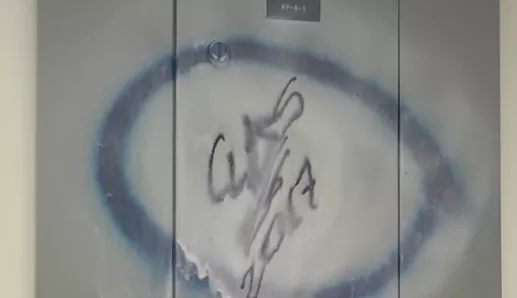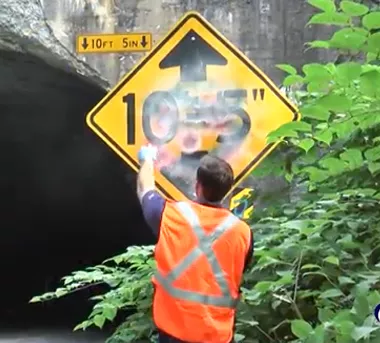Not all painters work in a studio. Some “artists” skulk around at night, vandalizing property with a spray can. Graffiti is a scourge, defacing public property and marring brick walls.
This time, it happened to you—well, your garage door. You thought you were safe in the suburbs, but taggers are everywhere.
Your first instinct may be to call the police, but that won’t solve the problem. Your second instinct might be to call a professional cleaning company, but don’t throw money at it just yet. Try to remove the graffiti yourself before incurring what could be a sizable expense.

Before you start…
First, assess the damage. Is it sizable? Depending on the amount of graffiti and the width of your garage door, it could take all weekend to remove the paint. If that’s daunting, review your insurance policy. Even better, call up the insurance company and ask if you’re covered for graffiti removal under the provision for damage. Depending on your policy’s deductible, it may or may not be worth it to file a claim. Still, it’s good to know your options when faced with a chore that will eat up all of your free time. Maybe it’s time for a new door anyway.
8 tips
Read these helpful hints at how to MacGyver the graffiti off your garage door:
- Do it now… right now. Discourage graffiti artists from returning to tag your door again by erasing their work as quickly as possible. The faster the better—as a deterrent but also as a strategy to remove the paint before it sets in and fully dries. Get outside to tackle the problem within 48 hours, preferably within 24 hours.

- Start using common household cleaners. Before spending money on specialized products, try to remove the graffiti with things you already have around the house. Test small areas and don’t resort to scouring brushes or wire brushes right away. Liquid detergents will work on water‑based spray paints. Then move up to mineral spirits, paint thinner, methanol (wood alcohol), rubbing alcohol or acetone (think nail polish remover). Protect your hands with gloves as the products you try become more abrasive. “Green” activists and wise grandmothers will tell you that a mixture of white vinegar and lemon juice will give you the same results without all the branding and packaging. As always, make a test on a small area of the graffiti and see if it is effective. Granted, more natural solutions are less likely to damage your door’s original baked‑on paint.
- Don’t forget the oven cleaner! That foaming stove cleaner that works miracles in your oven can lift off graffiti. Let it sit on the door for 15 minutes then wash it away with a damp cloth. It can be a messy job, just like the oven, so bring extra cloths and something to store your garbage.
- Use a pressure washer. Sometimes called a power washer. They can be rented from home renovation stores or borrowed from a friendly neighbour. Start using a low pressure, then build as needed. However, it will only push the paint deeper into aged or untreated wood.
- Invest in a professional product. When common household cleaners don’t work, graduate to a professional product. Through a paint dealer, you can buy a paint remover that takes between 25 and 30 minutes to work. It’s the same product that many public works departments use to remove graffiti left on metal surfaces, such as road signs. This type of product is also used by companies specialized in removing graffiti. Read the instructions carefully and be aware that you will probably damage the base coat of paint under the graffiti. Go slow.

- Do your homework. What type of spray paint did the tagger use? Is it water based or oil based? Graffiti artists often use less expensive paints, which are easier to remove (Small mercies). If the tagger used permanent ink or a stubborn enamel, it’s difficult to remove. In this case, think about repainting the whole door to save you the headache.
- Consider what’s underneath. Is the door wood, metal or something else? What type of paint is your door covered with under the graffiti? If it was manufactured with a baked‑on paint with a polyester base, it’s more resistant. If you had it repainted at a professional paint shop, call and ask what they used. Perhaps you repainted it yourself and still have the can in the basement. Knowing what’s underneath will help you use the right product. Also, assessing the age of the door is critical. Even if the exterior skin of your garage door has a baked‑on paint, with the passage of time and exposure to weather, the paint has lost its shine and resistance to attack from cleansers, taggers and the elements.
- Consider repainting. If your garage door is old, and possibly mildewed, it could be smarter to repaint the door than try to remove graffiti. It will be less frustrating, for sure. For best results, give the door a good cleaning to remove surface grease and dust. Next, apply a high‑quality primer and wait for it to dry thoroughly before adding a coat of exterior paint. If your door is from Garaga or is a door with a similar surface, then refer to our website for the instructions you’ll need to repaint it. Most major paint manufacturers have a visualize tool for exterior paint on their websites, so you can play around with colour combinations and find the perfect look to complement your front door. Keep in mind the designer rule that double and triple garage doors look best in light or neutral shades, while smaller doors can go darker. Keep dramatic shades—the cranberries, porcelain blues, emerald greens—for the front door.
When it’s time for a change
The splash of unwanted graffiti could be a sign—quite literally—to finally replace the garage door. Don’t overthink it. If you live near London, contact us at 519-685-9797.
We gladly give no‑obligation quotations by email.
Or come to our showroom and use our Design Centre to pick out the style of door that showcases your style of home. Need inspiration? Then take a look at our image gallery for ideas.

Add new comment